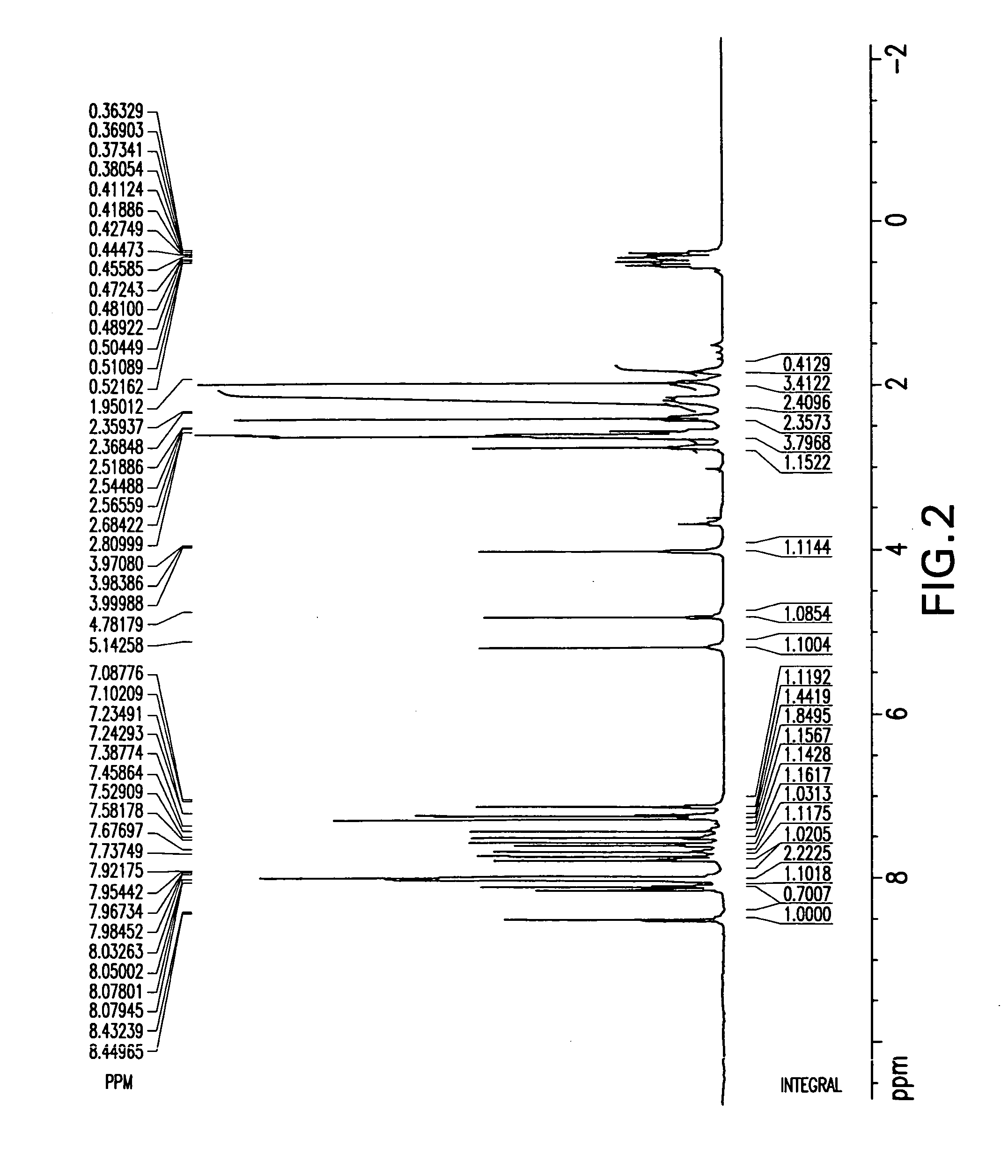Purification of montelukast
a technology of montelukast and purification method, which is applied in the field of purification of montelukast, can solve problems such as harm to patients
- Summary
- Abstract
- Description
- Claims
- Application Information
AI Technical Summary
Benefits of technology
Problems solved by technology
Method used
Image
Examples
example 1
The preparation of [R-(E)]-1-[[[3-[2-(7-chloro-2-quinolinyl)ethenyl]phenyl]-3-[2-(1-hydroxy-1-methylethyl)phenyl]propyl]thio]methyl]cyclopropaneacetic acid
[0131] A cold solution of the mesylate (2-(2-(3(S)-(3-(7-chloro-2-quinolinyl)-ethenyl)phenyl)-3-methanesulfonyl oxypropyl)phenyl-2-propanol) (about −5° C., 38 ml) was prepared from 10.1 g of the diol (MKT) ((S)-1-[[[1-[3-[2(E)-(7-chloro-2-quinolinyl) ethenyl]phenyl]]-3-[2-(1-hydroxy-1-methylethyl)phenyl]-1-propanol)). The mesylate solution was added to a cold solution of CYTAM (1-(mercaptomethyl)cyclopropaneacetic acid methyl ester) (5.05 g) in N,N-dimethylacetamide (−7° C., 20 ml). 47% NaOH (4.55 g) was added dropwise for 9 min, under intensive stirring. The reaction was exothermic; the temperature rose to −1° C. The clear, viscous reaction mixture was stirred for 1 h at −6° C., 1.5 h at 18° C., and heated to 38° C. in one hour. 47% NaOH (5.12 g) was added all at once and stirred overnight at 38° C. The reaction mixture (liquid ...
example 2
Enantiomeric purification by the preparation of [R-(E)]-1-[[[3-[2-(7-chloro-2-quinolinyl)ethenyl]phenyl]-3-[2-(1-hydroxy-1-methylethyl)phenyl]propyl]thio]methyl]cyclopropaneacetic acid isopropylamine salt
[0132] Isopropylamine (1.95 g) was added to the reaction mixture from the previous example. The clear reaction solution was stirred for 0.5 h at room temperature, and volatiles were removed by evaporation in a 55° C. bath under reduced pressure (20 mbar). The oily residue was dissolved in methylethylketone (40 ml) at 50° C., and the residual THF was stripped off with methylethylketone. The operation was repeated.
[0133] The residue, a heavy oil, was dissolved in hot methylethylketone (120 ml) at 71° C. The clear solution was gradually cooled for 0.5 h to 37° C. to induce crystallization. The suspension was held for 0.5 h at this temperature and gradually cooled to 0° C. in 1 h. The mixture was held for 1.3 h at 0° C. and filtered. The cake was washed with cold methylethylketone (0°...
example 3
3-[2-(1-hydroxy-1-methylethyl)phenyl]propyl]thio]methyl]cyclopropyl acetic acid Isopropyanmonium salt (MLK-IPAM)
[0135] S-MKT (4 kg) is reacted with methanesulfonyl chloride (1.4 kg) in the presence of DIPEA (2.2 Kg) in THF as solvent (20 liter) to yield the mesylate compound. During the reaction, the diisopropylethylamine hydrochloride (DIPEA•HCl) salt is formed. The salt is removed by filtration. The mother liquor, the THF solution of MKT-Mesylate, is then reacted with CYTAM (2.4 kg) in the presence of sodium hydroxide (2 kg) in a mixture of THF and DMA (4 L) to yield a solution of R-MLK-Me.
[0136] After the isolation step, the reaction mixture is heated gradually to 40° C. and treated with an additional amount of sodium hydroxide (2 kg). The solution is mixed for about 4 hrs to induce the hydrolysis of R-MLK-Me and yield the R-MLK-Na. The DMA and the other side products are removed by twice washing the reaction mixture with a dilute NaCl solution (each washing is with 20 liters o...
PUM
| Property | Measurement | Unit |
|---|---|---|
| temperature | aaaaa | aaaaa |
| temperature | aaaaa | aaaaa |
| temperature | aaaaa | aaaaa |
Abstract
Description
Claims
Application Information
 Login to View More
Login to View More - R&D
- Intellectual Property
- Life Sciences
- Materials
- Tech Scout
- Unparalleled Data Quality
- Higher Quality Content
- 60% Fewer Hallucinations
Browse by: Latest US Patents, China's latest patents, Technical Efficacy Thesaurus, Application Domain, Technology Topic, Popular Technical Reports.
© 2025 PatSnap. All rights reserved.Legal|Privacy policy|Modern Slavery Act Transparency Statement|Sitemap|About US| Contact US: help@patsnap.com



